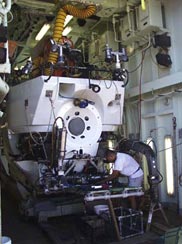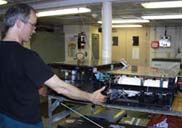|
|
||||||||||||||||||||||||||||||||||||||||||||||||||||||||||||||||||||||||||||||||||||||||||||||||||
 |
||||||||||||||||||||||||||||||||||||||||||||||||||||||||||||||||||||||||||||||||||||||||||||||||||
|
April 24, 2003 -- Are We There Yet? Gretchen Früh-Green and Dave Butterfield
We continue to speed along at about 12 knots to our site location. The seas are calm and other than some clouds in the morning, it is another bright sunny day. We advanced our clocks one hour ahead last night – a good sign that we are getting closer to our destination at 30°N. In the meantime, preparations are nearly finished in the labs and the Alvin pilots are continuing to give their pre-dive briefings.
This afternoon we had another science meeting at which Betsy Williams and Gretchen Früh-Green gave presen-tations about some of the results from the previous cruise to the Atlantis Massif. We discussed the types of rocks that make up the mountain and how these rocks are altered when they come into contact with seawater. Most of the rocks are mantle material that have been altered to a rock called serpentinite. Heat is released during this process and it is this heat that we believe is driving the hydrothermal activity and the formation of the vents at Lost City. Serpentinization is closely linked to tectonic activity in the area and requires that seawater can continue to get into the rocks through faults and fractures. Photomosaics put together by Betsy show us what the basement rocks look like underwater. The mantle rocks are deformed and are sharply truncated and overlain by sediments. Some of these sediments are rocks we call breccias, which contain different sized fragments of the basement rocks that are cemented together by light colored carbonate sediments. Each rock, whether sediment or mantle material, tells a story of how the Atlantis Massif and the vent field came to be. It will be our job to read their stories and discover the secrets of Lost City.
The Beast is not only big, but also complicated, therefore the need for testing. After hauling it out and putting it onto the platform (“basket”) in front of the sub (see photo), we connected the power and communication cable outside, and connected our laptop computer inside the submarine. There were no electrical problems, and the selection valve and two pumps both worked under computer control from inside the sub. This was way too easy, but we don’t mind. The Bosun (Wayne Bailey) is working on a device to help us get the Beast through those tight doorways, which will really tame the Beast. If only the plumbing of the Beast were that easy, but that is another story. |
||||||||||||||||||||||||||||||||||||||||||||||||||||||||||||||||||||||||||||||||||||||||||||||||||



